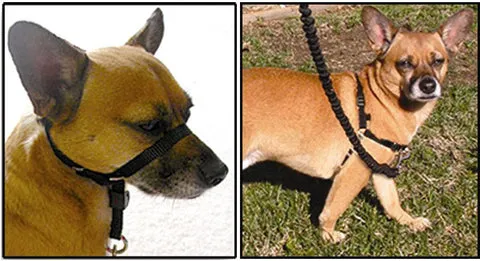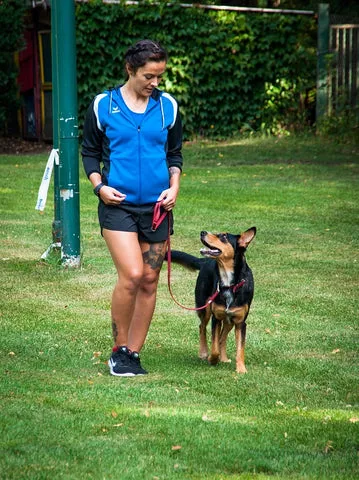Envision your furry companion walking serenely by your side, responding to your every halt and turn, and confidently passing other dogs and people without a tug. Imagine a world where your puppy only stops to sniff or relieve themselves with your permission, creating a truly harmonious walk. While teaching a puppy to walk politely on a leash might be one of the more challenging aspects of dog training, it is undoubtedly a rewarding effort that builds a stronger bond and more enjoyable outings. This comprehensive guide will show you how to train a puppy not to pull on the leash, making this vision a happy reality for both of you.
Essential Equipment Before You Start Leash Training
Before diving into the actual training, selecting the right equipment can significantly aid your efforts. While a head collar or a front-attachment harness can help discourage your dog from pulling, it’s important to understand that these tools are aids, not substitutes for proper leash training. They manage the pulling, but they don’t teach your dog to walk without pulling entirely. A front-attachment harness, for instance, is a safe and user-friendly no-pull device suitable for most dogs. For dogs with aggressive tendencies or those requiring maximum control, such as a large breed being walked by a smaller owner, a head collar can provide superior management.
It’s crucial to use these tools with a leash no longer than 6 feet. A longer leash could allow your dog to gain too much speed, potentially causing injury if they abruptly hit the end of the leash. Selecting the correct equipment is the first step in setting your puppy up for successful walks.
 A small tan dog wears a head collar on the left and a front-attachment harness on the right
A small tan dog wears a head collar on the left and a front-attachment harness on the right
The “Stop and Reward” Method
A foundational technique for how to stop a dog from pulling while walking is the “stop and reward” method. This simple yet effective approach involves immediately stopping your forward movement the moment your dog begins to pull. As soon as the leash slackens and your dog walks calmly by your side, reward them with a high-value treat. A treat bag worn on your waist can be incredibly useful for quick access to rewards. If your dog isn’t highly motivated by food, consider using a favorite tug toy, chew toy, or a tossed ball as a reward instead. The key is consistent reinforcement: pulling makes the walk stop, walking politely earns a reward.
Step-by-Step Puppy Leash Training
To effectively train your puppy not to pull, follow these detailed steps, starting in a low-distraction environment like your backyard. Consistency and patience are paramount throughout this process.
Step 1: Walking with My Human is Delicious!
Begin your puppy’s leash training by attaching them to a long rope or leash (10-20 feet, non-retractable) while they wear a standard harness. Prepare pea-sized pieces of high-value treats like fresh meat or cheese. Go to a familiar outdoor area, such as your backyard. Decide which side you prefer your dog to walk on (left is traditional). This will be the “reward zone” where treats appear.
Walk briskly and randomly around your yard. Whenever your puppy chooses to walk beside you, immediately offer praise and a treat at your thigh on your chosen side. If they continue walking politely, reward them for every few steps taken together. As they improve, you can gradually reduce the frequency of treats. If your puppy is initially uninterested in treats, bring them inside and try again when they are slightly hungrier. Practice this step until your puppy consistently stays by your side.
Step 2: It’s Worth My While to Watch Where My Human Is Going and Go Along, Too!
Start this step by walking around your yard again. Wait for a moment when your puppy is distracted, lagging, sniffing, or attempting to relieve themselves. In an upbeat voice, say “let’s go,” and the first few times, gently slap your thigh to ensure they notice you, then turn and walk in the opposite direction. The moment your puppy catches up, reward them with praise and a treat at your preferred side. Continue to reward them every couple of steps as long as they stay with you. If they catch up quickly, give an extra reward to emphasize their prompt response.
If the leash becomes tight and your puppy doesn’t come towards you, stop walking and apply gentle, consistent leash pressure. This pressure should serve as a reminder, not a force. Praise them and release the pressure as soon as they begin to move towards you. Reward them generously when they reach your side. Continue practicing until your puppy consistently returns to your side when you say “let’s go,” even if they’ve veered off.
Step 3: I Know When It’s Time to Smell (Or to Pee On) the Roses
While puppies need opportunities to sniff and relieve themselves, teaching them that you control these moments fosters better leash manners. Approximately every five minutes during your training session, at a time when you would typically offer a food reward, instead say something like “go sniff” and allow your puppy to explore or potty while on the leash. This is a privilege. If your puppy pulls during this “free time,” immediately say “let’s go” and change direction, effectively ending the sniff break. When you’re ready to resume walking politely, simply say “let’s go” and continue your walk. This teaches your puppy to value controlled sniff breaks.
Step 4: Sometimes I Really Need to Pay Attention to Where My Human Is Going!
Continue practicing steps one through three in your yard, gradually transitioning to a shorter leash, eventually reaching the standard 6-foot length. Introduce variations in your walking pace; practice walking extra fast, extra slow, stopping abruptly, and changing directions frequently. Reward your puppy if they can maintain their position by your side during these challenges.
As your puppy masters walking politely in normal circumstances, you can gradually reduce the frequency of rewards for simply walking by your side. However, continue to offer generous rewards when they successfully stay with you during unusual maneuvers or when encountering distractions like other animals or people. This helps to solidify their polite leash behavior in varied situations. The goal is for your puppy to confidently and happily walk with a slack leash. If you want to make sure your puppy loves the leash, start with positive experiences. How to get your puppy to like the leash involves making it a source of treats and fun from the very beginning.
Taking Leash Training to the Street
Once your puppy is proficient in the backyard, it’s time to introduce real-world distractions. On neighborhood walks, you will apply the same techniques, but be prepared for increased challenges from friendly strangers, squirrels, and other dogs. Using a front-attachment harness or head collar can provide extra control in these more stimulating environments. Always bring high-value treats like fresh meat or cheese.
Say “let’s go” and begin walking. If your puppy becomes distracted or starts to pull, immediately say “let’s go” and turn, walking in the opposite direction. Reward them generously with treats when they walk calmly beside you. It’s especially important to provide extra rewards when they manage to focus on you despite significant distractions. Remember to still offer authorized sniff breaks as a reward for polite walking.
 Woman walking an attentive black and tan dog on a leash
Woman walking an attentive black and tan dog on a leash
Challenging Your Dog During Leash Training
To further test and strengthen your puppy’s polite leash walking, introduce controlled challenges. Outfit your dog in a standard harness attached to a 6-foot leash. Hold the leash and toss a ball or treat about 20 feet away. If your puppy pulls towards the object, immediately say “let’s go” and turn, walking in the opposite direction. Only if they walk calmly beside you as you approach the object, allow them to reach it and take it as their reward. Initially, you might use a longer leash or a less desirable object to make this exercise easier.
Troubleshooting Common Leash Training Issues
Even with consistent training, you might encounter some common challenges:
- Dog Crossing in Front: If your puppy consistently crosses in front of you, shuffle or stomp your feet slightly to make your presence more obvious.
- Lagging Behind: If your dog lags significantly, they might be frightened or unwell. Use plenty of encouragement rather than pulling them along. If they are lagging to sniff or potty, simply keep walking, applying only gentle pressure on the leash, and reward them for catching up.
- Alternating Pulling and Polite Walking: If your dog alternates between pulling and walking politely after you’ve practiced these steps, stop rewarding them for simply returning to you after a pull. Instead, focus on rewarding them for taking longer, consecutive steps by your side.
How to Train a Dog to Walk on a Leash and Heel
Heel training is a specific command that encourages your dog to walk very closely and attentively by your side for short periods, which can be particularly useful when passing distractions. Begin practicing “heel” in your home. Place a treat in your fist and let your puppy sniff it. Say “let’s go” and take a couple of steps, leading them with your treat-filled fist near your thigh. Praise and reward them when they follow your fist with their nose.
Next, practice having your dog follow your empty fist, continuing to praise and reward them for every few steps they follow. Gradually increase your standards with each session. Your closed fist will serve as the consistent hand signal for “heel.” Once proficient indoors, introduce “heel” practice in more distracting environments outdoors.
This journey of teaching your puppy not to pull on the leash will lead to more enjoyable and stress-free walks for both of you. With patience, consistency, and positive reinforcement, you’ll foster a well-behaved companion ready for any adventure. Explore additional resources on effective dog training to enhance your canine companion’s skills and strengthen your bond.
